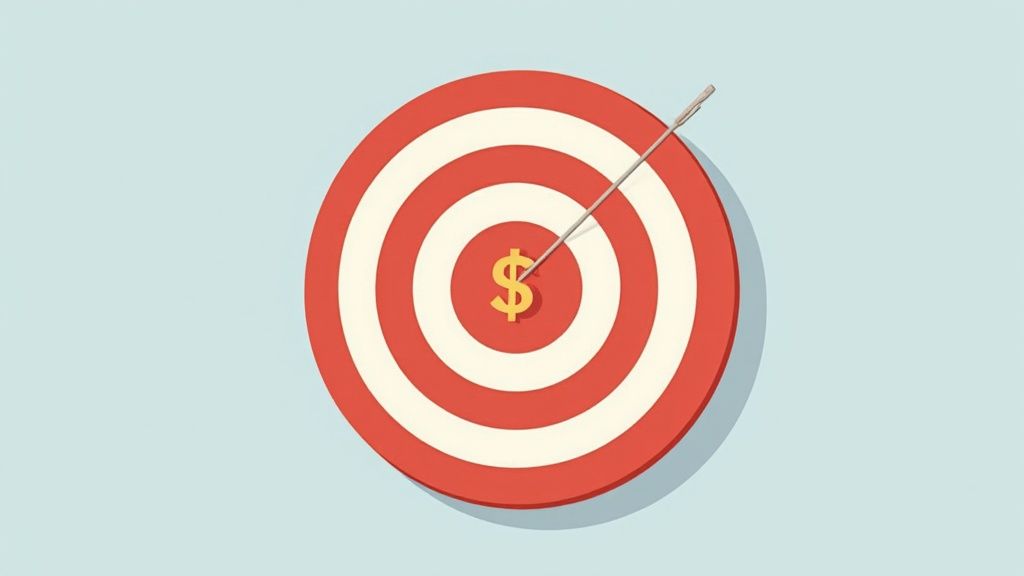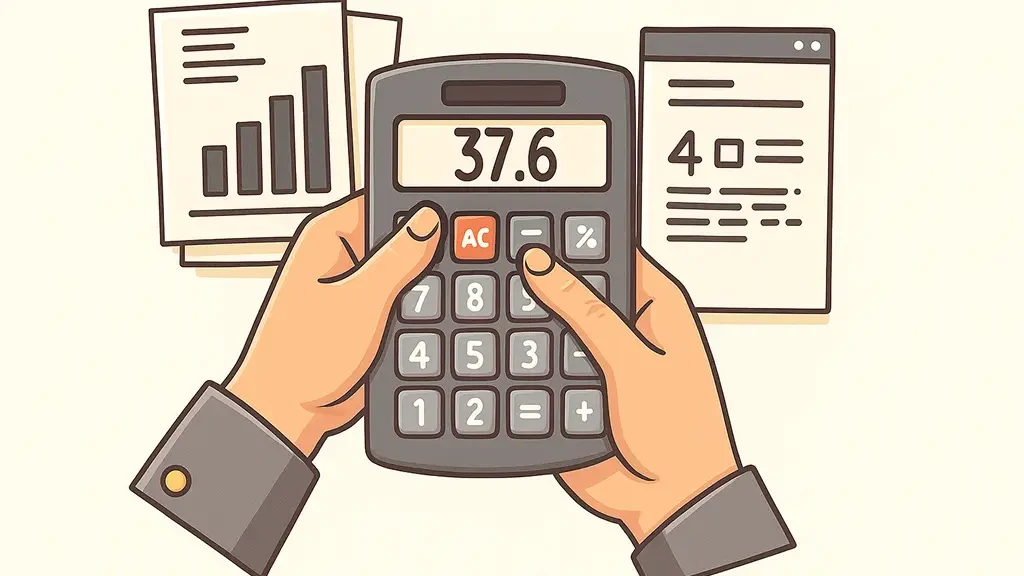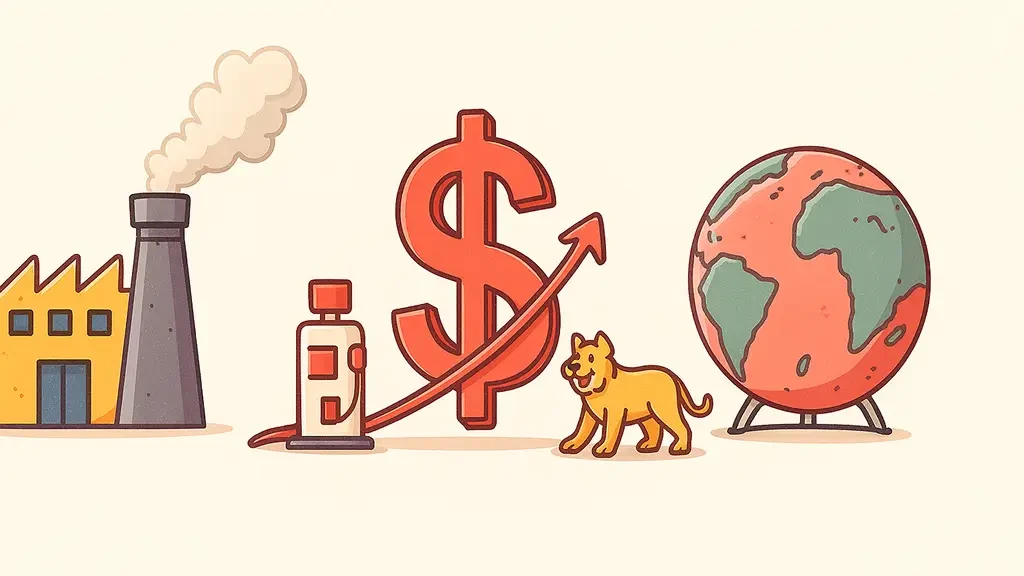What Is Price Target? How It Works & Why It Matters
Discover what is price target, how analysts determine it, and how understanding this can help you make smarter investment decisions. Learn more now!

A price target is a forecast from a professional analyst pinpointing where they believe a stock's price will be in the future, usually within 12 to 18 months. Think of it as a well-researched guidepost, not a guarantee. It’s a tool that helps frame your expectations and evaluate a stock’s potential.
Your Financial GPS: What Is a Price Target?

When you set out on a long drive, you plug a destination into your GPS. It gives you a route and a projected arrival time. A stock price target works almost identically, answering the big question for any investor: “Based on expert research, where could this stock be headed?”
Financial analysts are the cartographers of the stock market. They're the ones digging deep into company earnings reports, dissecting market trends, and analyzing economic conditions to produce these estimates. And just like a GPS reroutes you for traffic, analysts will update their price targets when new information—like a blowout earnings report or a new competitor—changes the landscape.
The Anatomy of a Price Target
A price target is much more than just a number; it’s the final chapter of a detailed investigation. An analyst arrives at this figure after a comprehensive analysis of a company's financial health, its growth prospects, the state of its industry, and the broader market environment. If you're curious about the mechanics, you can explore how analysts arrive at these figures.
At its core, a price target gives you three critical pieces of information to work with:
- A Specific Price: The projected value, like $150 per share.
- A Time Horizon: The period over which this price is expected to be reached, typically 12 months.
- A Recommendation: It's often paired with a “buy,” “hold,” or “sell” rating, which tells you what the analyst thinks you should do at the stock’s current price.
This framework transforms abstract market data into a tangible metric, giving you a clear guidepost for evaluating a stock's potential upside or downside.
Price Target Key Components at a Glance
To quickly understand what makes up a price target, here’s a simple breakdown of its core elements. Think of this table as a quick-reference guide to what you're really looking at when you see an analyst's forecast.
These components work together to provide a complete, actionable piece of analysis, not just a random number. They give you the "what," the "when," and the "why" behind the forecast.
How Price Targets Influence the Market

Price targets are much more than just an analyst's opinion scribbled in a research note; they are powerful catalysts that can move markets. When a respected Wall Street firm or a well-known analyst issues a new price target, they aren't just sharing a number. They're sending a signal that can spark immediate and sometimes dramatic reactions from investors.
These forecasts really came into their own in the late 20th century as dedicated equity research became a formal part of the financial world. Before then, investment decisions were often a bit of a black box. Today, a price target upgrade or downgrade is a major news event, followed closely by everyone from day traders to the managers of billion-dollar pension funds.
The influence is real and measurable. Look at the data from major exchanges: when a stock gets a price target upgrade, its price often gets a nice short-term bump. In 2023, for instance, US stocks that were upgraded by top-tier analysts saw their prices jump by an average of roughly 10% within three months of the news.
The Ripple Effect of an Analyst Call
Think of a price target announcement like a big rock tossed into a still pond. The immediate splash is the stock’s price jumping or falling. But the real impact comes from the ripples that spread outward, shaping broader market sentiment and sometimes even entire sectors.
An upgrade for a major tech company, for example, rarely lifts just that one stock. It can trigger a wave of optimism across the technology sector, boosting related companies and potentially helping lift an index like the Nasdaq 100. On the flip side, a high-profile downgrade can inject a dose of fear, prompting investors to second-guess their holdings across the industry.
A single analyst's price target revision can act as a powerful narrative-shifter. It can change how thousands of investors perceive a company's future, turning bullish sentiment to bearish—or vice versa—in a single trading session.
This ripple effect is exactly why these forecasts get so much attention. They offer a quick, digestible signal of expert opinion, which many people use as a shortcut for their own research.
Why This Forecast Matters to Investors
The shockwaves from a price target go far beyond a simple price pop or drop. They shape strategic decisions for investors at every level.
For an individual investor, a major upgrade might provide the final nudge of confidence needed to buy a stock or add to a position. For an institution, it can be the green light to deploy millions in capital.
These forecasts are also crucial when companies go through big changes. Events like a corporate restructuring can completely rewrite a company's valuation story, and fresh price targets give investors an essential guidepost for what to expect. To see how these events can impact share values, you might find our guide on what a stock split means for your investment helpful.
Ultimately, price targets help mold the market's collective agreement on what a stock is worth. This creates a kind of self-fulfilling prophecy where the forecast itself helps drive the very outcome it predicts.
The Art and Science of Calculating Price Targets

Ever wonder how a Wall Street analyst lands on a precise figure like $150 per share? Calculating a price target is a blend of rigorous math and human judgment—part science, part art. It’s not about gazing into a crystal ball. It’s about building a structured, defensible case for a company’s future value.
Analysts lean on a few sophisticated models to get there. The two most common toolkits are absolute valuation and relative valuation. They might sound complex, but the core ideas are actually quite intuitive.
The Science of Valuation Models
This is the "science" part of the equation, where analysts use established financial models to translate a company's data into a concrete number. It’s all about projecting future worth based on what we know today.
One of the workhorses here is Discounted Cash Flow (DCF) analysis. Think of it like valuing an apple orchard. You wouldn't base its worth on this year's harvest alone. Instead, you'd estimate the cash you’ll collect from every future harvest, and then "discount" that future money back to what it’s worth today. A DCF model does exactly that for a business, forecasting all its future cash flows to arrive at a single, present-day value per share.
Then there's Relative Valuation. This is a lot like pricing a house. You don’t just pull a number out of thin air; you look at what similar homes in the neighborhood recently sold for. For stocks, analysts compare a company’s financial multiples—like its Price-to-Earnings (P/E) ratio—to those of its direct competitors. If other tech companies in the same space trade at 25 times their earnings, an analyst might apply that same multiple to the target company’s projected earnings to estimate a fair stock price.
A price target is ultimately a story about a company's future, supported by numbers. The quantitative models provide the plot points, while the qualitative factors color in the narrative.
The Art of Qualitative Factors
Numbers alone never tell the full story. This is where the "art" comes in. An analyst must also weigh the intangible factors that can’t be neatly plugged into a spreadsheet. These subjective judgments are often why two smart analysts can look at the same company and arrive at very different price targets.
Key qualitative elements include:
- Management Quality: Is the leadership team experienced, innovative, and trustworthy? A visionary CEO can be a company’s most powerful asset.
- Brand Strength: How strong is the company's brand? A name like Apple or Coca-Cola commands customer loyalty and pricing power that numbers struggle to capture.
- Competitive Moat: Does the company have a durable advantage—like patents, network effects, or high switching costs—that keeps rivals at bay?
- Industry Trends: Is the company riding a long-term tailwind, like the shift to renewable energy or the explosion in artificial intelligence?
Analysts often build these calculations on solid financial projections templates, which help structure their forward-looking view. Even so, they have to make critical judgment calls. These judgments are also shaped by market events like stock splits, which can change investor psychology and liquidity. You can learn more about that in our guide on what a stock split history means for investors.
By weaving hard data together with these nuanced insights, an analyst constructs a complete picture to justify their final price target.
How to Use Price Targets in Your Strategy

Knowing what a price target is is the first step. But the real magic happens when you start weaving this tool into your actual investment decisions. A price target isn't just a number to glance at; it’s a practical metric that helps you size up opportunities and sharpen your thinking about where a stock might be heading.
The most direct way to use it? Compare a stock's current market price to its consensus price target. This simple check gives you a quick read on the potential upside or downside that analysts, as a group, are forecasting.
For example, if a stock is trading at $80 and has a consensus target of $100, analysts collectively see a potential 25% upside over the next 12 months. On the flip side, if that same stock is already at $120 with a $100 target, they’re sending a clear signal that it might be overvalued.
Why the Consensus View Matters
While a single analyst’s bold call can grab headlines, experienced investors tend to lean on the consensus price target. This is simply the average target from all the analysts covering a stock. Think of it as the wisdom of the crowd, which often smooths out the extreme views of any one person.
An individual analyst might be a little too optimistic or pessimistic based on their unique model. The consensus, however, balances out these individual quirks and outliers, giving you a more grounded and often more reliable signal of where the market's head is at.
You can usually find this data on major financial news sites or right inside your brokerage platform. Look for these key numbers:
- High Target: The most bullish forecast on the Street.
- Low Target: The most bearish forecast.
- Average/Consensus Target: The mean of all available analyst targets.
- Number of Analysts: How many experts are weighing in.
Pay attention to the spread between the high and low targets, too. A wide gap signals significant disagreement and uncertainty about the company’s future. A tight range suggests the experts are largely on the same page.
To help put these numbers in context, here’s how analyst ratings generally line up with their price targets.
Interpreting Analyst Recommendations and Price Targets
This table offers a quick guide to how different analyst ratings often correspond with price target positioning, helping you decode the signals behind the jargon.
Seeing these ratings alongside the targets gives you a much richer picture of the overall sentiment.
A price target should be a starting point for your research, not the final word. Use it as a signal to dig deeper and ask why analysts believe the stock is headed in that direction.
Building Your Investment Thesis
At the end of the day, a price target is just one piece of the puzzle. It’s most powerful when you use it to kickstart your own independent research. If you spot a stock with an impressive consensus target, your next move is to find out why.
Are analysts excited about a new product launch? Expanding market share? Improving profit margins? Your job is to verify these claims and see if the story holds up. This is a crucial part of building an investment thesis you can feel confident in. This investigative process is a core component of any serious financial analysis. For a broader look at this discipline, understanding what is due diligence is a great next step.
By connecting the "what" (the price target) with the "why" (your own research), you shift from just following the crowd to making truly informed, strategic decisions.
Common Pitfalls of Relying on Price Targets
Price targets are an incredibly useful tool, but they aren’t a crystal ball. Perhaps the single biggest mistake an investor can make is treating them as a guaranteed outcome. It’s far healthier to see them for what they are: educated estimates, not promises etched in stone.
The financial world moves fast, and the assumptions that an analyst painstakingly builds into a price target can be wiped out overnight. A surprise economic downturn, an unexpected pivot on interest rates, or a disruptive new competitor can make a detailed model totally irrelevant. These external shocks are a huge reason why even the most well-researched targets often miss the mark.
A price target is just a snapshot based on the information we have today. When the landscape changes tomorrow, the target's validity can change right along with it. Real diligence means constantly re-evaluating forecasts as new information comes to light.
If you look at the statistics, the track record is decent but far from perfect. Research on a decade of Wall Street analyst predictions shows that, on average, price targets get about 70% to 80% of the way to their predicted value within that typical 12-month window. The average miss between a target and the actual price can be around 10-15%, which shows you there's a built-in margin for error. You can see the data for yourself to get a better sense of historical accuracy.
Hidden Biases and Human Factors
Beyond the unpredictable market, we have to remember the human element. Analysts, for all their efforts to stay objective, can be swayed by subtle biases. This isn't about intentional deception; it's just that certain pressures are part of the job.
For instance, analysts need to maintain good relationships with the companies they cover. Slapping a harsh "Sell" rating or a rock-bottom price target on a stock can sometimes get you cut off from management—a primary source of information. This can create a natural lean toward more optimistic forecasts.
Then there's the "herding" effect. Analysts can be hesitant to stray too far from the consensus view. After all, if you're the lone outlier and you're wrong, you stick out like a sore thumb.
Company-Specific Surprises
Even in a perfectly stable economy, a company-specific event can completely derail the most logical price target. These are the curveballs that change a company’s entire outlook:
- Scandals or Legal Troubles: An unexpected lawsuit or a scandal involving a key executive can do serious damage to a company’s reputation and, by extension, its stock price.
- Product Flops: A highly anticipated product that bombs in the market can wipe out billions in projected revenue, making old forecasts look silly.
- Operational Stumbles: Major supply chain disruptions or production delays can cause a company to miss its own earnings guidance, making an analyst’s price target impossible to reach.
Events like these, or even something like a sudden stock split announcement, introduce new variables that simply weren't in the original calculation. This is why having historical context is so valuable. You can dig into a company's financial history with resources like our Apple stock split history guide to better understand these nuances.
Ultimately, a price target is just one tool in a big toolbox. It’s powerful when used correctly, but relying on it exclusively is a risky game.
Frequently Asked Questions About Price Targets
Even after you get the hang of what price targets are and how they work, a few practical questions always pop up. Let's tackle some of the most common ones investors ask when they start putting this knowledge into practice.
How Often Are Price Targets Updated?
Analysts typically refresh their price targets every quarter, right after a company drops its latest earnings report. This is when they get a fresh flood of hard data to plug into their financial models, making it the perfect time to fine-tune their assumptions. A big earnings beat or a disappointing miss is almost guaranteed to trigger a wave of target revisions across Wall Street.
But they don't just stick to a quarterly schedule. Analysts will absolutely issue new targets anytime something significant happens.
These event-driven updates are crucial to watch for and can be sparked by things like:
- A major merger or acquisition announcement.
- The launch of a game-changing product, like a new AI chip or a blockbuster drug.
- Sudden shifts in the economy, such as an unexpected interest rate hike.
- Big news from a key competitor that shakes up the industry landscape.
This keeps the what is price target analysis from becoming a stale, outdated number. It’s a living forecast that adapts to new information.
What Should I Do If a Stock Falls Far Below Its Price Target?
When a stock you own plummets way below its consensus price target, it's a signal to do your homework, not to hit the panic button. That gap between price and target could be a massive buying opportunity, or it could be a serious red flag. Your job is to figure out which it is.
First, find out why it dropped. Did the whole market tank, dragging everything down with it? Or was there a problem specific to the company or its industry? Next, check to see if analysts are scrambling to lower their targets in response. If the company’s story has soured and targets are getting slashed, that original forecast is probably worthless now.
If the consensus target is holding firm and the company's long-term prospects still look solid, a steep price drop could be a golden opportunity to buy. But if the fundamentals have truly deteriorated, that low price might be justified, and the old target is simply obsolete.
Your move should always come back to a fresh look at your original investment thesis. Use the price drop as a reason for new due diligence, not a trigger for a knee-jerk reaction.
Why Do Analysts Have Different Price Targets for the Same Stock?
It’s completely normal to see a wide range of price targets for the same company. In fact, you should expect it. This highlights the "art" that’s mixed in with the science of valuation. Different analysts arrive at different numbers because they’re all working with slightly different assumptions.
One analyst might be super bullish on a new product and project aggressive revenue growth, while another stays more conservative. They might use different discount rates in their DCF models or put a higher value on intangible assets like brand strength. One analyst might see a new technology as a world-beater, while another sees it as a costly distraction.
This is exactly why smart investors don’t fixate on a single analyst’s opinion. Instead, they look at the consensus or average price target. It smooths out the most extreme bull and bear cases, giving you a more balanced view. The range itself is also revealing—a wide spread between the highest and lowest targets often signals a lot of uncertainty and healthy debate about the stock's future.
Ready to move beyond basic price targets and see how your portfolio could truly perform? PinkLion offers AI-powered asset forecasts and scenario simulations that let you stress-test your investments against real-world possibilities. Uncover hidden risks and opportunities with professional-grade tools designed for every investor. Start for free at PinkLion.
